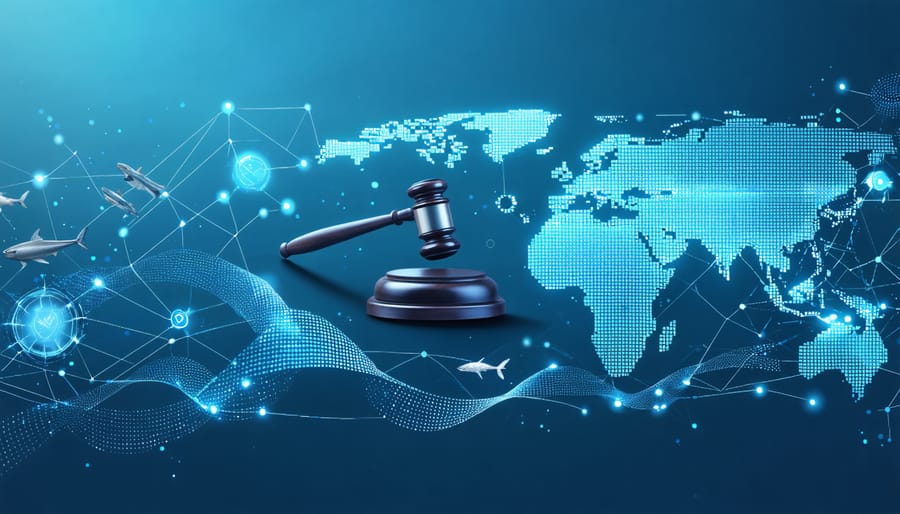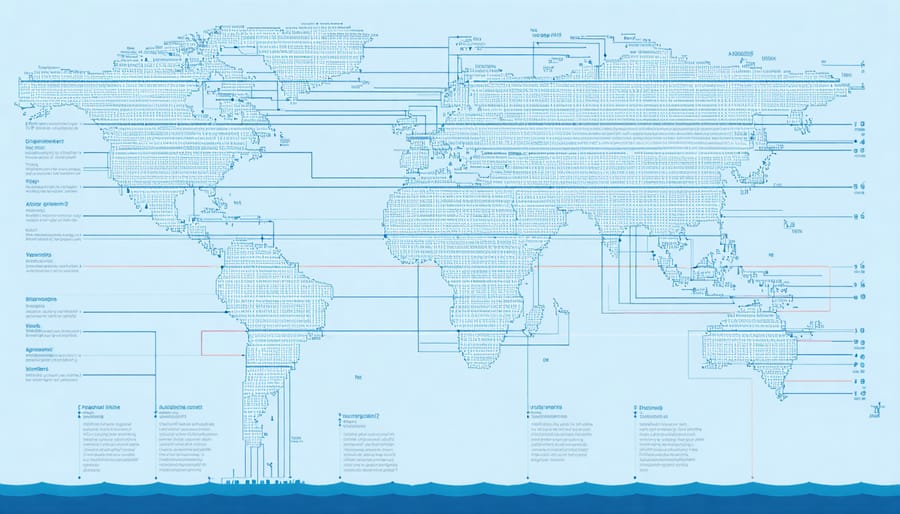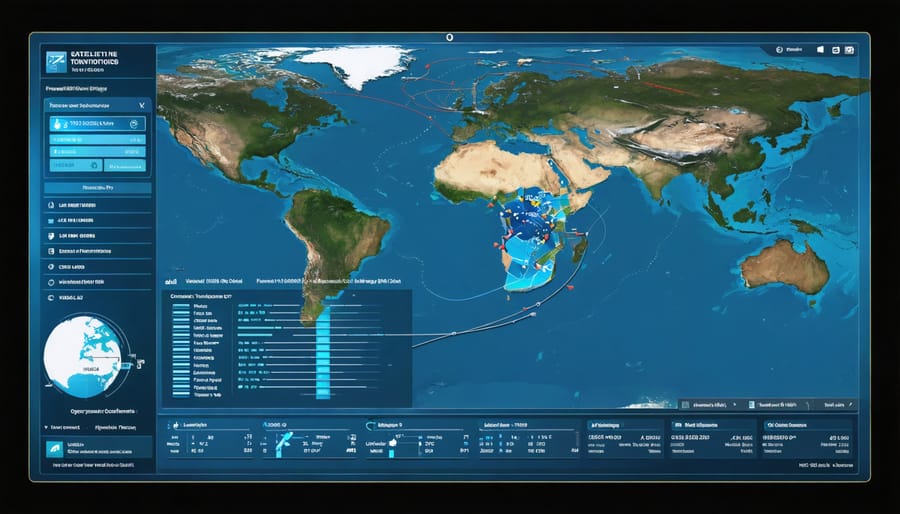
Our oceans face unprecedented challenges, from rising temperatures to plastic pollution, making effective coastal marine management more crucial than ever. The implementation of robust ocean policies represents humanity’s coordinated response to protect these vital ecosystems that cover 71% of Earth’s surface. These policies, ranging from international maritime laws to local conservation initiatives, form the backbone of marine resource management and environmental protection efforts worldwide.
While traditional approaches focused primarily on commercial fishing regulations, modern ocean policies encompass a broader spectrum of concerns: biodiversity preservation, pollution control, climate change mitigation, and sustainable resource utilization. This comprehensive framework reflects our evolving understanding of marine ecosystems’ interconnectedness and their critical role in planetary health.
Success in ocean policy implementation requires collaboration between governments, scientific institutions, local communities, and international organizations. Through carefully crafted regulations, monitoring systems, and enforcement mechanisms, these policies create a blueprint for sustainable ocean management while balancing environmental protection with economic interests. The future of our oceans depends on strengthening these frameworks and ensuring their effective implementation across all maritime nations.
The Framework of Modern Ocean Policies
Key International Maritime Laws
The United Nations Convention on the Law of the Sea (UNCLOS), often called the “Constitution for the Oceans,” forms the cornerstone of international maritime law. Established in 1982, this comprehensive framework governs everything from territorial waters to deep-sea mining, providing the foundation for sustainable ocean development worldwide.
UNCLOS divides marine spaces into distinct zones, each with specific regulations. The territorial sea extends 12 nautical miles from a nation’s coastline, where the coastal state maintains full sovereignty. Beyond this lies the exclusive economic zone (EEZ), reaching 200 nautical miles, where nations have special rights over marine resources while ensuring environmental protection.
Other crucial international frameworks complement UNCLOS, including the International Maritime Organization (IMO) conventions. The MARPOL Convention prevents ship-based pollution, while the International Convention for the Safety of Life at Sea (SOLAS) sets safety standards for merchant ships.
Regional seas agreements further strengthen ocean governance. The Barcelona Convention protects the Mediterranean Sea, while the OSPAR Convention safeguards the Northeast Atlantic. These regional frameworks address specific challenges while maintaining consistency with UNCLOS principles.
Together, these laws create a complex but essential network of protection for our oceans, balancing economic interests with environmental conservation needs. They provide the legal foundation for addressing modern challenges like plastic pollution, climate change impacts, and biodiversity loss in marine environments.

Regional Ocean Management Agreements
Regional ocean management agreements have emerged as powerful tools for protecting marine ecosystems that span multiple national jurisdictions. These collaborative frameworks enable neighboring countries to coordinate their conservation efforts and establish consistent standards for marine resource management.
Notable examples include the Mediterranean Action Plan, which brings together 21 countries to protect the Mediterranean Sea’s biodiversity, and the Commission for the Conservation of Antarctic Marine Living Resources (CCAMLR), which manages marine resources in the Southern Ocean. These agreements demonstrate how regional cooperation can effectively address challenges like overfishing, pollution, and habitat destruction.
The success of these arrangements relies heavily on shared monitoring systems, coordinated enforcement efforts, and regular scientific data exchange. For instance, the Coral Triangle Initiative, involving six Southeast Asian nations, has successfully implemented collaborative programs to protect coral reefs and enhance sustainable fisheries management.
Marine scientists and conservationists have observed that regions with strong cooperative agreements typically show better conservation outcomes. These partnerships often facilitate knowledge sharing, capacity building, and the development of innovative solutions to complex marine challenges. They also create opportunities for joint research projects and the establishment of transboundary marine protected areas, essential for preserving migratory species and maintaining ecosystem connectivity.
Implementation Strategies That Work
Scientific Monitoring Systems
Modern scientific monitoring systems serve as the backbone of ocean policy enforcement, combining cutting-edge technology with traditional observation methods. Satellite tracking systems, such as Vessel Monitoring Systems (VMS), provide real-time data on ship movements, helping authorities identify potential illegal fishing activities and violations of marine protected areas.
Advanced sonar technology and underwater acoustic monitoring devices track marine life movements and detect unauthorized vessel presence. These systems work alongside environmental DNA (eDNA) sampling, which allows scientists to identify species present in an area by analyzing water samples for genetic material.
Automated identification Systems (AIS) have revolutionized vessel tracking, making it harder for illegal operators to avoid detection. When combined with machine learning algorithms, these systems can predict patterns of non-compliance and direct enforcement resources more effectively.
Remote sensing technologies, including drones and autonomous underwater vehicles (AUVs), conduct regular surveillance missions, capturing high-resolution imagery and environmental data. These tools are particularly valuable in monitoring coral reef health, water quality, and marine pollution levels.
Citizen science initiatives complement these technological solutions, with trained volunteers contributing valuable observational data through mobile apps and online platforms. Marine biologist Dr. Sarah Chen notes, “The combination of high-tech monitoring and community involvement creates a powerful network for protecting our oceans.”
Data integration platforms bring these various monitoring streams together, creating comprehensive pictures of ocean health and policy compliance. This integrated approach allows authorities to respond quickly to violations while also gathering long-term data on policy effectiveness and marine ecosystem changes.
Enforcement Mechanisms
Effective enforcement of ocean policies relies on a multi-layered approach combining international cooperation, technology, and on-the-ground monitoring. Maritime law enforcement agencies work alongside coast guards and naval forces to patrol protected areas and enforce fishing quotas. Satellite monitoring systems and vessel tracking devices help authorities identify illegal fishing operations and unauthorized entry into marine protected areas.
Recent technological advances have revolutionized enforcement capabilities. Drone surveillance provides cost-effective monitoring of vast ocean areas, while AI-powered image recognition helps identify vessels violating regulations. Advanced radar systems and automatic identification system (AIS) tracking make it increasingly difficult for vessels to operate undetected.
Financial penalties serve as a crucial deterrent, with fines scaling according to violation severity and potential environmental impact. Some nations have implemented point systems for commercial fishing vessels, where repeated violations can result in license suspension or revocation. Port state measures allow authorities to deny port access to vessels suspected of illegal fishing activities.
Community-based enforcement programs have proven particularly effective in coastal areas. Local fishing communities, trained in monitoring techniques and equipped with reporting tools, act as guardians of their marine resources. These programs not only improve compliance but also create sustainable employment opportunities and strengthen community engagement in conservation efforts.
International cooperation frameworks enable coordinated enforcement actions across maritime boundaries. Regional fisheries management organizations (RFMOs) facilitate information sharing and joint operations between member states. This collaborative approach has significantly improved the detection and prosecution of illegal fishing operations and other marine policy violations.
Successful enforcement often depends on capacity building in developing nations, where resources for monitoring and enforcement may be limited. International aid programs provide training, equipment, and technical support to enhance enforcement capabilities in these regions.

Compliance Monitoring in Action

Satellite Tracking Success Stories
Satellite tracking has revolutionized ocean policy enforcement, with numerous success stories demonstrating its effectiveness. In 2019, a coordinated effort between Global Fishing Watch and Indonesian authorities led to the successful identification and arrest of multiple illegal fishing vessels operating in protected waters. The satellite data revealed suspicious vessel behavior patterns, enabling authorities to intercept five industrial-scale fishing boats carrying illegal catches worth millions.
Another remarkable example comes from the Great Barrier Reef Marine Park, where satellite monitoring helped reduce illegal fishing activities by 60% over three years. Park rangers used real-time tracking data to optimize patrol routes and respond quickly to potential violations, significantly improving enforcement efficiency.
In the Mediterranean, a collaborative project between European nations utilized satellite technology to track oil spills and identify responsible vessels. This initiative resulted in a 40% reduction in illegal discharge incidents and successful prosecution of multiple offenders. The evidence gathered through satellite imagery proved crucial in court proceedings.
The South Pacific region showcases another success story, where satellite tracking helped identify and stop a network of vessels engaged in shark finning. The technology enabled authorities to track vessel movements across vast ocean areas, leading to international cooperation that dismantled the illegal operation in 2021.
These achievements highlight how satellite technology has become an indispensable tool in protecting our oceans and ensuring compliance with maritime regulations.
Community-Based Monitoring Programs
Community-based monitoring programs have emerged as powerful tools for ensuring compliance with ocean policies while fostering local stewardship of marine resources. These initiatives engage coastal communities directly in the protection and surveillance of their marine environments, creating a sense of ownership and responsibility among residents.
Local fishermen, dive operators, and community members participate in regular monitoring activities, collecting data on fish populations, coral health, and potential violations of marine protection laws. This grassroots approach has proven particularly effective in regions where government enforcement resources are limited.
For example, in the Philippines, the Bantay Dagat (Sea Guardian) program has successfully reduced illegal fishing activities by involving local volunteers in patrol operations. Similar programs in Hawaii have enabled indigenous communities to integrate traditional ecological knowledge with modern conservation practices, leading to improved compliance with fishing regulations.
These community-based programs often include educational components, teaching participants about marine ecosystems and sustainable practices. This knowledge-sharing creates a ripple effect, as informed community members become advocates for ocean conservation within their social networks.
Success metrics from various programs worldwide show that areas with active community monitoring typically experience higher rates of policy compliance and faster recovery of marine ecosystems. The model has proven so effective that many international conservation organizations now prioritize community engagement in their marine protection strategies.
Future of Ocean Policy Enforcement
The future of ocean policy enforcement is being revolutionized by emerging technologies and innovative approaches to marine conservation. Satellite monitoring systems, coupled with artificial intelligence, are transforming how we track illegal fishing activities and protect marine protected areas. These advanced systems can now identify vessels engaged in suspicious behavior with unprecedented accuracy, allowing authorities to respond more quickly and effectively.
Drone technology is becoming increasingly central to enforcement efforts, offering cost-effective surveillance of vast ocean areas. These unmanned vehicles can monitor marine ecosystems, detect pollution events, and even collect evidence of policy violations without putting human observers at risk. Combined with underwater autonomous vehicles, these technologies create a comprehensive monitoring network that spans both surface and subsurface environments.
Blockchain technology is emerging as a powerful tool for ensuring transparency in fishing supply chains and supporting blue economy initiatives. By creating immutable records of catch data and vessel movements, blockchain systems make it harder for illegal operators to falsify documentation or bypass regulations.
Community-based enforcement programs are gaining traction, with local stakeholders playing crucial roles in monitoring and reporting violations. These initiatives often combine traditional knowledge with modern technology, creating more effective and culturally appropriate enforcement mechanisms. Mobile apps now enable citizens to report violations instantly, while educational programs help build awareness and encourage compliance.
Looking ahead, environmental DNA (eDNA) monitoring shows promise for biodiversity assessment and species tracking, while machine learning algorithms are becoming more sophisticated at predicting potential violation hotspots. These innovations, combined with international cooperation and capacity building, are creating a more robust and adaptive enforcement framework for ocean policies.
The integration of these technologies with traditional enforcement methods is creating a more comprehensive and effective approach to ocean protection. As these systems become more accessible and affordable, even smaller nations and organizations can implement sophisticated monitoring programs, leading to better global compliance with marine conservation policies.
Ocean policies represent our collective commitment to protecting the marine environment for future generations. Throughout this exploration of ocean policy frameworks, we’ve seen how international cooperation, scientific research, and community engagement work together to create effective marine conservation strategies. The success of these policies relies heavily on continued support from both government bodies and engaged citizens.
The implementation of comprehensive ocean policies has already shown promising results, from the recovery of endangered marine species to the restoration of damaged coral reef systems. However, there is still much work to be done. Climate change, plastic pollution, and overfishing continue to threaten our oceans, making robust policy frameworks more critical than ever.
You can make a difference by supporting ocean policy initiatives in several ways. Consider joining local marine conservation groups, participating in beach cleanups, or contacting your representatives about ocean protection legislation. For those in academic or scientific fields, contributing to research that informs policy decisions is invaluable. Even small actions, like reducing single-use plastics or choosing sustainable seafood, help advance policy goals.
The future of our oceans depends on strong policies and dedicated individuals working together. By understanding and supporting ocean policies, we can ensure the preservation of marine ecosystems for generations to come. Let’s commit to being active participants in ocean conservation, whether through professional involvement, volunteer work, or daily sustainable choices.
jessica
Ava Singh is an environmental writer and marine sustainability advocate with a deep commitment to protecting the world's oceans and coastal communities. With a background in environmental policy and a passion for storytelling, Ava brings complex topics to life through clear, engaging content that educates and empowers readers. At the Marine Biodiversity & Sustainability Learning Center, Ava focuses on sharing impactful stories about community engagement, policy innovations, and conservation strategies. Her writing bridges the gap between science and the public, encouraging people to take part in preserving marine biodiversity. When she’s not writing, Ava collaborates with local initiatives to promote eco-conscious living and sustainable development, ensuring her work makes a difference both on the page and in the real world.
